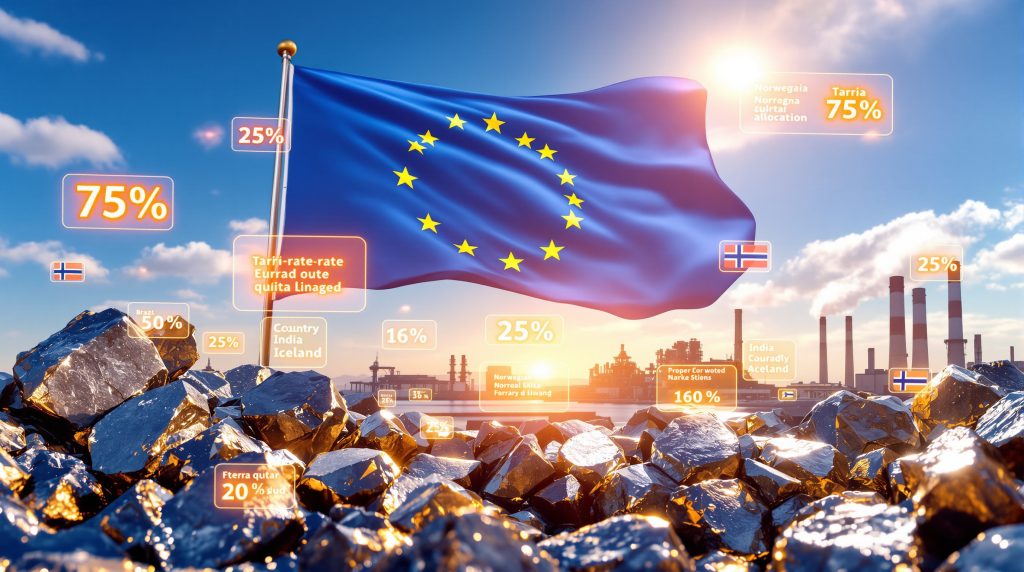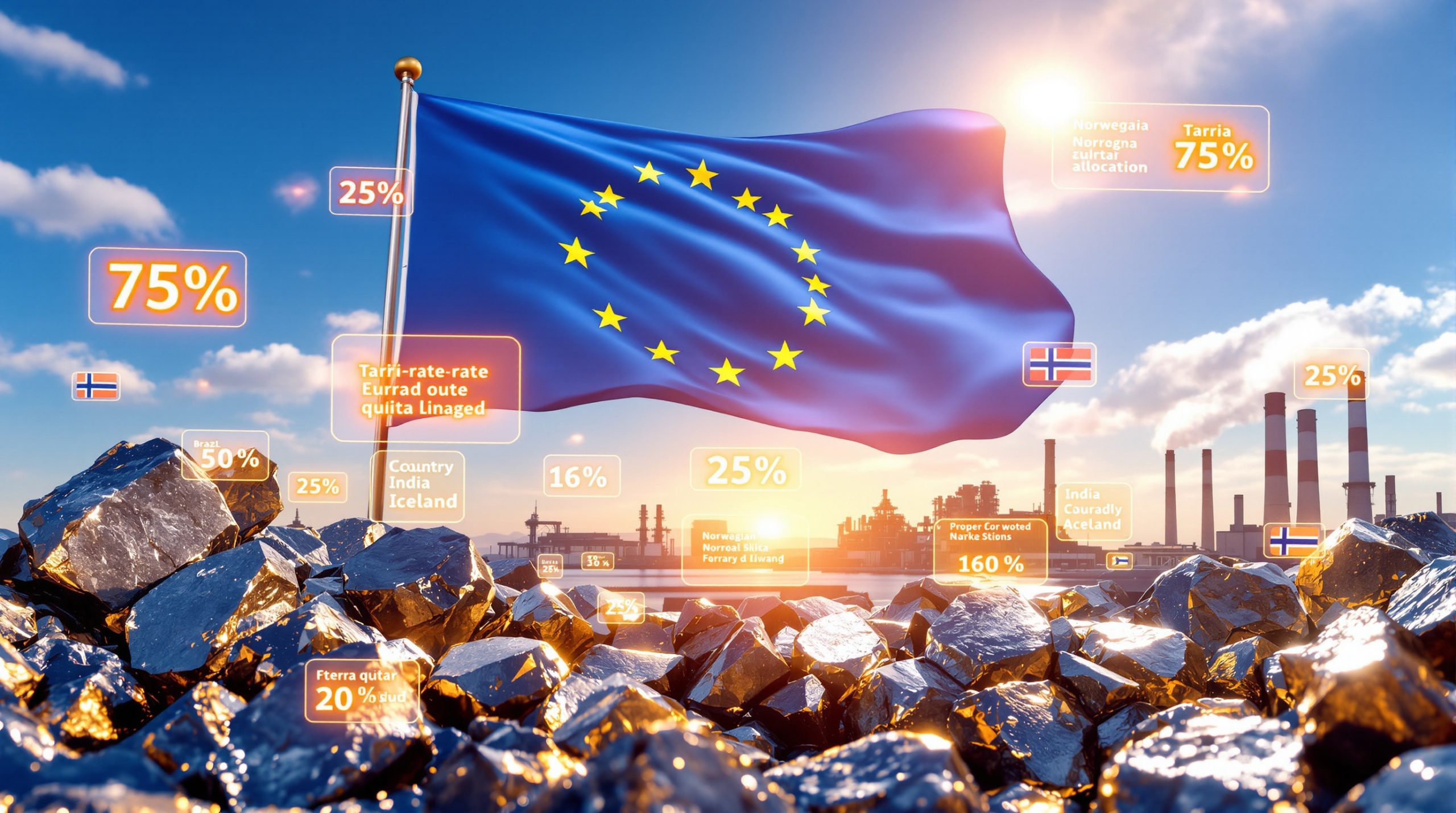Understanding the Regulatory Framework Behind Ferro-Alloy Protection
The EC imposes safeguard measures on ferro-alloys as global trade defense mechanisms have evolved significantly beyond traditional anti-dumping measures, with modern safeguard frameworks addressing volume-based market disruptions rather than price discrimination practices. The European Commission's recent implementation of comprehensive ferro-alloy protections illustrates this shift toward strategic industrial resilience within commodity sectors.
Trade safeguards function as emergency protection tools, providing temporary relief when domestic industries face serious injury from unexpected import surges. Unlike anti-dumping duties targeting unfair pricing, these measures respond to legitimate competitive pressures through volume management rather than punitive tariffs.
What Are Safeguard Measures and How Do They Function?
The European Union's safeguard implementation for ferro-alloys employs a sophisticated tariff-rate quota (TRQ) mechanism combined with variable duty structures. This approach permits 75% of traditional import volumes to enter duty-free, based on historical patterns from the 2022-2024 baseline period. Volumes exceeding this threshold face variable duties calculated as price differentials rather than fixed protective barriers.
The out-of-quota variable duty equals the difference between established price thresholds for each product category and actual import prices, creating a price floor mechanism that maintains market access while preventing excessive volume growth. This distinction from conventional trade defense tools reflects the EU's commitment to balancing protection with supply chain continuity.
Market participants have expressed significant concerns about implementation clarity following the November 18, 2025 voting approval. Trading activities have been suspended across multiple firms as companies await detailed procedural guidance for quota allocation and customs clearance processes, highlighting how tariffs impact markets across various sectors.
The Legal Architecture of EU Trade Defense
The regulatory approval process revealed unusual procedural complexities, with voting postponements from the originally scheduled November 14 date through to final approval on November 18, 2025. This extended timeline suggests significant member state negotiations regarding scope and implementation details.
The measures took effect immediately on November 19, 2025, establishing a three-year implementation period with quarterly review mechanisms. The legal framework explicitly permits safeguard measures under existing EU-EEA agreements, despite concerns raised by Nordic partners regarding inclusion in the protective scope.
European Commission officials confirmed that safeguard mechanisms remain legally permissible under current EEA arrangements, with quarterly consultation processes designed to address Norwegian and Icelandic concerns while maintaining protective effectiveness. Furthermore, these developments reflect broader US trade defense trends influencing global trade policy approaches.
Which Ferro-Alloy Products Face New Import Restrictions?
The protective scope encompasses four critical manganese and silicon-based ferro-alloys essential for steel production and industrial manufacturing processes, while notably excluding silicon metal and calcium silicon despite industry advocacy efforts.
Covered Products Under the Safeguard Regime
| Product Category | HS Code | Status | Primary Applications |
|---|---|---|---|
| Ferro-manganese | 7202.11 | Included | Steel deoxidation, alloying |
| Silico-manganese | 7202.30 | Included | Steel production, casting |
| Ferro-silicon | 7202.21 | Included | Steel industry, chemical processes |
| Ferro-silico-magnesium | 7202.99 | Included | Nodular iron production |
| Silicon metal | N/A | Excluded | Chemical industry applications |
| Calcium silicon | N/A | Excluded | Specialty steel applications |
The European chemicals industry maintained strong opposition to silicon metal inclusion, reflecting downstream manufacturing concerns about input cost increases. Ferroglobe, a major European ferro-alloys producer, stated it will continue advocating for silicon metal inclusion in future safeguarding measures, indicating ongoing industry pressure for expanded scope.
Notable Exclusions and Their Strategic Implications
The selective product approach demonstrates complex stakeholder balancing between upstream raw material security and downstream manufacturing competitiveness. Euroalliages, the ferro-alloys industry association, urged silicon metal inclusion despite the European Commission's decision to exclude it from protective coverage.
This exclusion pattern reflects the EU's consideration of entire value chain impacts, weighing ferro-alloy producer interests against chemical industry requirements for competitively priced silicon metal inputs. The decision establishes precedent for future trade defense scope determinations involving interconnected industrial sectors, particularly those involving raw materials transition requirements.
How Do Tariff-Rate Quotas Reshape Import Dynamics?
The implementation mechanism establishes country-specific quota allocations based on historical import patterns, fundamentally altering competitive dynamics within European ferro-alloy distribution networks.
Quota Allocation Methodology
The regulatory structure permits duty-free access for three-quarters of traditional import volumes, with excess quantities subject to variable duties calculated as price threshold differentials. This dual-tier system aims to maintain essential supply flows while discouraging excessive volume growth.
Market participants have suspended trading activities pending clarification of customs clearance procedures and quota allocation mechanics. Industry executives report they are not currently purchasing material due to uncertainty about the ability to clear customs under the new regulatory framework.
The measures are expected to reshape European ferro-alloy trading patterns, with larger companies securing significant quota tonnages while smaller operators face operational viability challenges due to additional compliance costs and volume restrictions. These changes mirror broader tariffs economic impact patterns observed globally.
Geographic Coverage and Country-Specific Impacts
Primary Supplier Countries Subject to Measures:
- Brazil
- China
- India
- Malaysia
- South Africa
- Thailand
- Zambia
EEA Partners Included:
- Norway
- Iceland (with quarterly consultation mechanisms)
Excluded Jurisdictions:
- Ukraine (geopolitical considerations)
- Developing countries below 3% import threshold
- Least developed country classifications
What Are the Market Structure Implications?
The regulatory intervention creates significant consolidation pressures within trading networks while generating new volatility-based profit opportunities for market participants capable of navigating regulatory complexity.
Anticipated Industry Consolidation Effects
Market analysis suggests the measures will fundamentally transform European ferro-alloy trading operations. Larger companies with greater administrative capabilities are expected to secure substantial quota allocations, while smaller trading entities face severe operational pressure due to compliance cost burdens.
Industry participants describe the changes as transformational, with one trader noting that regulatory compliance will create additional costs without improving underlying market conditions. However, increased price volatility may provide opportunities for smaller companies capable of identifying profit margins within the new regulatory environment.
Price Volatility and Trading Pattern Changes
The quota system introduces new variables into pricing mechanisms, potentially increasing short-term volatility while creating arbitrage opportunities for entities capable of managing regulatory complexity. Market participants expect significant disruption to established trading relationships as companies adapt to volume limitations and compliance requirements.
Steel industry executives report purchasing hesitation due to implementation uncertainty, with concerns about securing first-quarter material supplies under unclear customs clearance procedures. This demand-side caution contributes to market instability during the transition period.
Why Were Norway and Iceland Included Despite EEA Membership?
The inclusion of European Economic Area partners represents a significant policy decision prioritising EU industrial protection over traditional regional trade preferences, marking a notable shift in EU-Nordic commercial relations.
Legal Justification Under EEA Framework
European Commission officials emphasise that safeguard measures remain explicitly permitted under existing EU-EEA agreements, establishing legal precedent for including Nordic partners in protective frameworks. The quarterly consultation mechanism provides adjustment opportunities while maintaining measure effectiveness.
The European Commission announced that the price threshold structure is designed to favour Norwegian and Icelandic suppliers, whose prices generally exceed those of other suppliers. This premium positioning allows Nordic producers to access EU markets above quota thresholds at established minimum prices, partially offsetting volume restrictions through value enhancement.
Economic Impact on Nordic Producers
Norway's Export Position:
Elkem, the Norwegian ferro-silicon and silicon producer, exports 160,000 tonnes of ferro-silicon to the EU annually. The company anticipates sales volume reductions in EU markets compensated by increased market prices under the protective framework.
Capacity Utilisation Concerns:
European ferro-alloy producers outside the EU region expect to idle production capacity due to limited alternative market opportunities. This constraint reflects the EU's dominant position as a destination market for European Economic Area ferro-alloy production.
Industry Association Perspectives:
Euroalliages opposed Norwegian and Icelandic inclusion while welcoming quarterly review mechanisms. Conversely, some traders supported Nordic inclusion as essential for maintaining higher European price levels, citing Norway's significant share of EU imports as a primary market concern.
How Do These Measures Compare to Global Trade Defense Trends?
The EU's safeguard approach reflects broader international movements toward industrial protection amid supply chain vulnerabilities and evolving geopolitical tensions affecting critical materials trade.
US Trade Defense Precedents
American ferro-alloy protection measures have redirected global trade flows, contributing to import surge conditions that triggered EU safeguard investigations. This demonstrates the interconnected nature of trade defense actions across major economic blocs, where protective measures in one jurisdiction create displacement effects requiring response mechanisms elsewhere.
The sequential implementation of trade defense measures across jurisdictions illustrates coordination challenges in global commodity markets, where protection in primary markets creates secondary disruptions requiring additional regulatory intervention. These dynamics align with the US critical minerals order priorities for strategic material security.
Strategic Autonomy Considerations
The ferro-alloy safeguards align with broader EU objectives including the Critical Raw Materials Act and Green Deal Industrial Plan, demonstrating coordinated policy development across multiple regulatory frameworks. These measures support domestic industrial capacity maintenance for strategic sectors including defense, automotive, and renewable energy applications.
The regulatory approach reflects EU strategic autonomy priorities, reducing critical material dependencies while maintaining industrial capabilities essential for economic security and technological sovereignty within key manufacturing sectors.
What Implementation Challenges Await Market Participants?
The transition to quota-based trading introduces operational complexities requiring significant adaptation in procurement planning, customs procedures, and supply chain management practices.
Administrative and Compliance Requirements
Documentation Needs:
- Country-of-origin certification processes
- Quota utilisation tracking systems
- Price threshold monitoring mechanisms
- Customs clearance procedure compliance
Timing Considerations:
- Quarterly quota allocation cycles
- Real-time import monitoring requirements
- Advance procurement planning necessities
Market participants face uncertainty regarding customs clearance capabilities under the new framework, with concerns about securing material supplies for upcoming quarterly periods. This procedural ambiguity creates procurement planning challenges for industrial consumers requiring consistent ferro-alloy input availability.
Supply Chain Adaptation Strategies
Industrial consumers must adjust procurement strategies to accommodate volume limitations and potential price increases while maintaining production schedules and cost competitiveness. This adaptation requires renegotiation of supply relationships and development of alternative sourcing arrangements within quota constraints.
The regulatory framework demands enhanced coordination between trading entities and end-users, with increased emphasis on advance planning and risk management to ensure supply continuity under volume-limited market conditions.
When Will Market Conditions Stabilise Under New Rules?
The three-year implementation period provides adjustment time for supply chain adaptation, though market stabilisation depends on effective administrative system implementation and industry response to regulatory constraints.
Short-Term Market Disruption Factors
Initial implementation phases involve trading pattern disruptions as quota allocations are established and compliance systems operationalised. Price discovery challenges emerge under regulatory constraints, while supply chain relationships require renegotiation to accommodate volume limitations.
Market participants expect continued volatility during the first year as administrative procedures are refined and trading patterns adapt to quota-based allocation systems. This transition period will test both regulatory implementation effectiveness and industry adaptability to constrained volume conditions.
Long-Term Structural Adjustments
Industry Adaptation Timeline:
- Year 1: Quota allocation establishment and initial compliance system development
- Year 2: Market pattern stabilisation and supply relationship optimisation
- Year 3: Preparation for potential measure extension or termination evaluation
Long-term market evolution depends on regulatory effectiveness in achieving industrial protection objectives while maintaining supply chain functionality. Success metrics include domestic industry stabilisation, supply security maintenance, and downstream sector competitiveness preservation.
What Are the Broader Policy Implications?
These safeguard measures represent components of larger European strategy balancing open trade commitments with industrial resilience objectives, establishing precedents for future trade defense applications.
Integration with EU Industrial Policy
The ferro-alloy protection aligns with broader initiatives including critical materials legislation and green industrial transformation plans, demonstrating coordinated policy development across regulatory frameworks. This integration reflects EU commitment to maintaining industrial capabilities while advancing environmental and economic transformation objectives.
The measures support strategic autonomy goals through domestic production capacity preservation, reducing external dependencies in sectors critical for technological sovereignty and economic security.
Precedent Setting for Future Trade Defense
Successful implementation may influence European Commission approaches to other sectors facing similar import pressures, particularly in critical materials and strategic industries. The regulatory framework establishes templates for balancing protective measures with supply chain continuity requirements.
The inclusion of EEA partners despite regional trade preferences demonstrates prioritisation of industrial protection over traditional commercial arrangements, potentially influencing future EU trade policy development across various sectors. According to Reuters reporting, these measures reflect ongoing European efforts to strengthen domestic industrial capacity.
Regulatory Outlook Considerations
The analysis presented reflects current regulatory frameworks and market conditions. Trade policy measures remain subject to modification based on implementation effectiveness, industry feedback, and evolving market dynamics. Market participants should consult official European Commission guidance for definitive procedural requirements and compliance obligations.
The European Commission's ferro-alloy safeguard measures mark a significant evolution in EU trade policy, establishing new paradigms for industrial protection within global commodity markets. Market adaptation success will depend on effective administrative system implementation, industry response to regulatory constraints, and maintenance of essential supply flows for downstream manufacturing sectors. Consequently, the EC imposes safeguard measures on ferro-alloys establishing precedents for future EU trade defense applications across strategic industrial sectors during this three-year implementation timeline.
Ready to Identify the Next Strategic Materials Opportunity?
Discovery Alert's proprietary Discovery IQ model delivers real-time notifications on significant ASX mineral discoveries, instantly identifying actionable opportunities in critical materials sectors before broader market awareness develops. Explore how major mineral discoveries can generate substantial returns by visiting Discovery Alert's dedicated discoveries page, and begin your 30-day free trial today to position yourself ahead of market developments in strategic materials and industrial metals.




